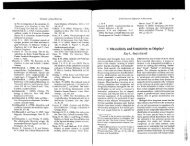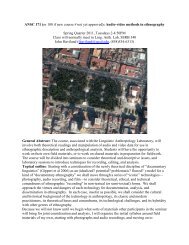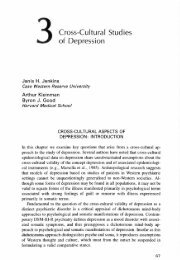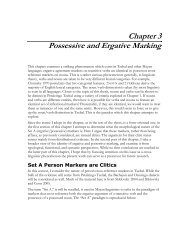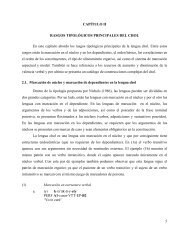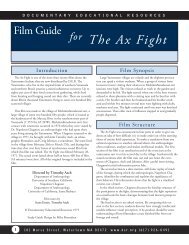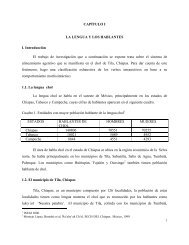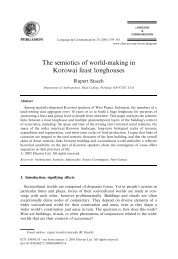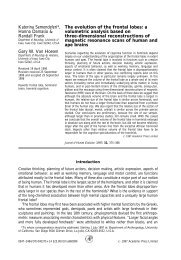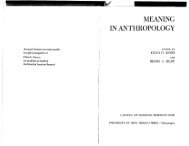Shifters and Verbal Categories
Shifters and Verbal Categories
Shifters and Verbal Categories
You also want an ePaper? Increase the reach of your titles
YUMPU automatically turns print PDFs into web optimized ePapers that Google loves.
388 MEANING IN LANGUAGE: GRAMMATICAL AND LEXICA1 Shifirrs <strong>and</strong> Vrrhal Cate,qories 389<br />
Fido, but they do not share any property of "Fidone\s." Also thc indefinite<br />
pronoun corresponding to names such as Jean. Jan, Joan. Junethe<br />
"what's-her-name" or "what-do-you-call-her" or "how-d'ye-callherw-includes<br />
a patent reference to the code.<br />
MIC) A message referring to the code is in logic termed an AUTONY-<br />
MOUS mode of speech.' When we say, The pup is u ~c*insome anitncrl or<br />
The pup is rvhlmpering, the word pup designates a young dog, whereas<br />
in such sentences as "Pup" is a nom which means ci young dog or. more<br />
briefly, "Pup" means a young dog or "Pup" is u monosyllable, the word<br />
pup-one may state with Carnap (1937)-is used as its own designation.<br />
Any elucidating interpretation of words <strong>and</strong> sentences-whether intralingual<br />
(circumlocutions, synonyms) or interlingual (translation)-is a<br />
message referring to the code. Such a hypostasis-as Bloomfield<br />
(1933: 148) pointed out-"is closely related to quotation, the repetition of<br />
speech," <strong>and</strong> it plays a vital role in the acquisition <strong>and</strong> use of language.<br />
CIM) Any linguistic code contains a particular class of grammatical<br />
units which Jespersen (1922b) labeled SHIFTERS: the general meaning of<br />
a shifter cannot be defined without a reference to the message.<br />
Their semiotic nature was discussed by Burks (1949) in his study on<br />
Peirce's classification of signs into symbols, indices, <strong>and</strong> icons.<br />
According to Peirce, a symbol (for example the English word red) is<br />
associated with the represented object by a conventional rule, while an<br />
index (such as the act of pointing) is in existential relation with the object<br />
it represents. <strong>Shifters</strong> combine both functions <strong>and</strong> belong therefore to<br />
the class of INDEXICAL SYMBOLS. AS a striking example Burks cites the<br />
personal pronoun. I means the person uttering I. Thus on one h<strong>and</strong>, the<br />
sign I cannot represent its object without being associated with the latter<br />
"by a conventional rule," <strong>and</strong> in different codes the same meaning is<br />
assigned to different sequences such as I, ego, ich, <strong>and</strong> ja: consequently<br />
I is a symbol. On the other h<strong>and</strong>, the sign I cannot represent its object<br />
without "being in existential relation" with this object: the word I des-<br />
ignating the utterer is existentially related to his utterance <strong>and</strong> hence<br />
functions as an index (see Benveniste 1956).<br />
The peculiarity of the personal pronoun <strong>and</strong> other shifters was often<br />
believed to consist in the lack of a single, constant, general meaning.<br />
Husserl (1913): "The word 'I' designates a different person in each case<br />
<strong>and</strong> it does this always by means of a new meaning." For this alleged<br />
multiplicity of contextual meanings, shifters in contradistinction to sym-<br />
bols were treated as mere indices (Buhler 1934). Every shifter, however,<br />
possesses its own general meaning. Thus I means the addresser (<strong>and</strong><br />
you, the addressee) of the message to which it belongs. For Bertr<strong>and</strong><br />
Russell, shifters, or in his terms "egocentric particulars," are defined by<br />
the fact that they never apply to more than one thing at a time. This.<br />
hpwever, is common to all the syncategorematic terms For example the<br />
con.iunction twt each time expresses ;in adversative relation between two<br />
stated concepts <strong>and</strong> not the generic idea of contrariety. In fact, shifters<br />
are distinguished from all other constituents of the linguistic code solely<br />
by their compulsory reference to the given message.<br />
The indexical symbols. <strong>and</strong> in particular the personal pronouns. which<br />
the Humboldtian tradition conceives of as the most elementary <strong>and</strong> primitive<br />
stratum of language, are. on the contrary. a complex category where<br />
code <strong>and</strong> message overl;rp. Therefore pronouns belong to the late acquisitions<br />
in child language <strong>and</strong> to the early losses in aphasia. If we observe<br />
that even linguistic scientists had difficulties in defining the general<br />
meaning of the term i (or you), which signifies the same intermittent<br />
function of different subjects, it is quite obvious that the child who has<br />
learned to identify himself with his proper name will not easily become<br />
accustomed to such alienable terms as the personal pronouns: he may<br />
be afraid of speaking of himself in the first person while being called yo11<br />
by his interlocutors. Sometimes he attempts to redistribute these appellations.<br />
For instance, he tries to monopolize the first person pronoun:<br />
"Don't dare call yourself I. Only I am I, <strong>and</strong> you are only you." Or he<br />
uses indiscriminately either I or you both for the addresser <strong>and</strong> the<br />
addressee so that this pronoun means any participant of the given dialogue.<br />
Or finally I is so rigorously substituted by the child for his proper<br />
name that he readily names any person of his surroundings but stubbornly<br />
refuses to utter his own name: the name has for its little bearer only a<br />
vocative meaning, opposed to the nominative functiqn of I. This attitude<br />
may persevere as an infantile survival. Thus Guy de Maupassant confessed<br />
that his name sounded quite strange to him when pronounced by<br />
himself. The refusal to utter one's own name may become a social<br />
custom. Zelenin (1930) notes that in the Samoyed society the name was<br />
taboo for its carrier.<br />
Jim told me "Jicksks" tneans "movies." This brief utterance includes all<br />
four types of duplex structures: reported speech (MIM), the autonymous<br />
form of speech (MIC), a proper name (CIC), <strong>and</strong> shifters (CIM), namely<br />
the first-person pronoun <strong>and</strong> the preterit, signaling an event prior to the<br />
delivery of the message. In language <strong>and</strong> in the use of language, duplicity<br />
plays a cardinal role. In particular, the classification of grammatical, <strong>and</strong><br />
especially verbal, categories requires a consistent discrimination of<br />
shifters.<br />
Attempt to Classify. <strong>Verbal</strong> <strong>Categories</strong><br />
In order to classify the verbal categories two basic distinctions are<br />
to be observed:



